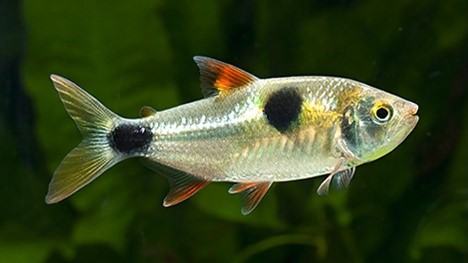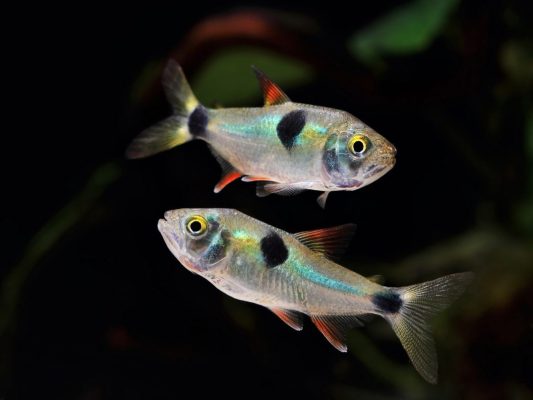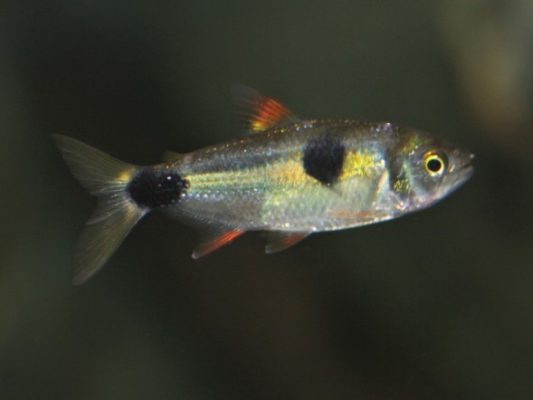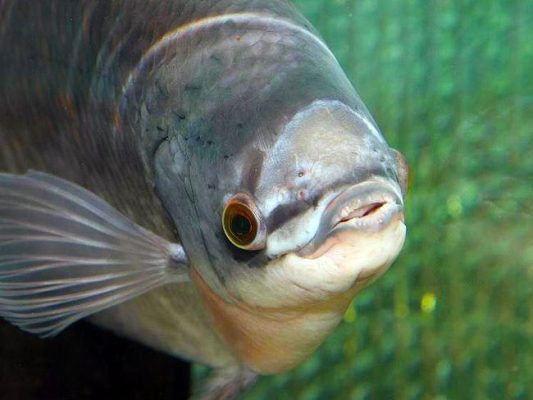Bucktooth Tetra

Table of Contents
- Introduction
- Taxonomy and Classification
- Physical Description
- Behavior and Social Structure
- Feeding Habits
- Reproduction and Life Cycle
- Exodon paradoxus in the Aquarium Trade
- Conclusion
Introduction
Exodon paradoxus, commonly known as the bucktooth tetra, is a fascinating species of wild fish that has captured the attention of aquarium enthusiasts worldwide. With its unique characteristics and importance in the aquarium trade, the bucktooth tetra stands out as a captivating and sought-after addition to any aquatic collection.
The Bucktooth Tetra, as its name suggests, is known for its distinct dental feature – a set of prominent bucktooth-like teeth that protrude from its mouth. These teeth, which are used for feeding purposes, add to the overall charm and intrigue of this species.
Apart from its distinctive teeth, the bucktooth tetra possesses several other unique characteristics that make it a prized species in the aquarium trade. Its body is elongated and streamlined, allowing for swift and agile movement in the water. The coloration of the bucktooth tetra is another striking feature, with its body adorned in vibrant shades of silver and black, creating a visually stunning display.
In addition to its aesthetic appeal, the bucktooth tetra also plays a crucial role in maintaining the ecological balance within aquarium ecosystems. As a carnivorous species, it helps control the population of small invertebrates and other fish species, contributing to the overall health and stability of the aquatic environment.
The popularity of the bucktooth tetra in the aquarium trade can be attributed to its captivating appearance, unique behaviors, and relative ease of care. Its active schooling nature and compatibility with a variety of tank mates make it a popular choice among hobbyists. Furthermore, its adaptability to different water conditions and relatively low maintenance requirements make it an ideal choice for both beginner and experienced aquarium enthusiasts.
The bucktooth tetra’s significance in the aquarium trade extends beyond its visual appeal and ease of care. It also serves as an educational tool, allowing enthusiasts and researchers to observe and study fish behavior, feeding habits, and social dynamics in a controlled environment. This species provides valuable insights into the intricacies of aquatic ecosystems and contributes to our understanding of fish evolution and ecology.
The bucktooth tetra, also known as Exodon paradoxus, is a captivating species of wild fish that has garnered attention and admiration in the aquarium trade. With its unique characteristics, including its prominent bucktooth-like teeth, vibrant coloration, and active schooling behavior, this species adds both visual appeal and ecological value to aquarium ecosystems. Its popularity among hobbyists, ease of care, and scientific significance make it a species worth appreciating and protecting. As responsible aquarium enthusiasts, it is important to promote sustainable practices and conservation efforts to ensure the continued existence and well-being of the bucktooth tetra and other fascinating aquatic species.
Taxonomy and Classification
Scientific Classification of Exodon paradoxus
Exodon paradoxus, commonly known as the Bucktooth Tetra, belongs to the Animalia kingdom, the Chordata phylum, the Actinopterygii class, the Characiformes order, and the Characidae family. Its scientific name, Exodon paradoxus, reflects its unique characteristics and behavior.
Taxonomic History and Related Species
The taxonomic history of Exodon paradoxus is an intriguing journey that has undergone several revisions and debates. Initially described by the renowned Swedish naturalist Carl Linnaeus in 1758, it was classified under the genus Salmo as Salmo paradoxus. However, further studies and advancements in taxonomy led to its reclassification.
In 1844, the French zoologist Achille Valenciennes assigned Exodon paradoxus to the genus Exodon, which is derived from the Greek words “exo” meaning “outside” and “odon” meaning “tooth.” This name perfectly captures the distinctive feature of its prominent, bucktooth-like teeth.
Exodon paradoxus is the sole species within the Exodon genus, making it unique and distinct from other related species. However, it shares some similarities with other characins, such as the piranhas (Serrasalmus spp.) and the pacus (Colossoma spp.), due to their shared ancestry and similar ecological roles.
The taxonomic classification of Exodon paradoxus showcases its evolutionary lineage and highlights its distinctiveness within the fish kingdom. By understanding its taxonomic history and related species, we can gain valuable insights into its evolutionary adaptations, behavior, and ecological niche.
Note: The information provided in this section is based on scientific literature, taxonomic databases, and expert opinions. It is essential to consult reliable sources and stay updated with the latest taxonomic revisions to ensure accuracy in classification.
Physical Description
General Appearance of Exodon paradoxus
Exodon paradoxus, commonly known as the Bucktooth Tetra, is a visually striking species of wild fish that captures the attention of aquarists and researchers alike. With its unique physical attributes, this species stands out among its aquatic counterparts.
Size, Shape, and Coloration
The Bucktooth Tetra exhibits a streamlined body shape, allowing it to swiftly navigate through its natural habitats. It typically reaches a maximum length of around 4 inches (10 centimeters), making it relatively small compared to other species in the aquarium trade.
One of the most captivating aspects of Exodon paradoxus is its vibrant coloration. The body of this species is predominantly silver, creating a shimmering effect as it gracefully moves through the water. What truly sets it apart is the presence of distinct black markings along its body. These markings resemble irregular vertical stripes that extend from the top of the fish’s back down to its belly. The contrasting colors create a visually stunning display, making the Bucktooth Tetra an attractive addition to any aquarium.
Distinctive Features: Bucktooth-like Teeth
Perhaps the most remarkable feature of Exodon paradoxus is its unique dentition, which earned it the common name “Bucktooth Tetra.” This species possesses a pair of prominent, elongated, and slightly curved teeth in its lower jaw. These teeth resemble the shape of buckteeth, protruding slightly from the fish’s mouth even when it is closed.
The purpose of these specialized teeth is twofold. Firstly, they aid in capturing and holding onto prey items, as the Bucktooth Tetra is a carnivorous species. These teeth allow it to firmly grasp its prey, ensuring a successful catch. Secondly, they play a crucial role in establishing dominance and defending territory within its social structure. During aggressive encounters, these teeth can be used as weapons, inflicting harm upon rivals or intruders.
The presence of these bucktooth-like teeth not only adds to the visual appeal of Exodon paradoxus but also serves as a testament to the remarkable adaptations that have evolved in this species over time.
In conclusion, Exodon paradoxus, the Bucktooth Tetra, exhibits a striking physical appearance that captivates the attention of aquarists and researchers. Its streamlined body shape, vibrant silver coloration with distinct black markings, and unique bucktooth-like teeth make it a visually stunning species. These distinctive features not only contribute to its aesthetic appeal but also serve functional purposes in capturing prey and establishing dominance within its social structure. The Bucktooth Tetra is truly a remarkable species that deserves recognition and appreciation in the world of aquatic life.
Distribution and Habitat
Natural Range of Exodon paradoxus
Exodon paradoxus, commonly known as the Bucktooth Tetra, is native to the Amazon basin in South America. Its natural range spans several countries, including Brazil, Peru, Colombia, and Venezuela. Within this region, it can be found in various river systems, including the Amazon River and its tributaries.
Specific Habitats
Exodon paradoxus primarily inhabits freshwater habitats, particularly rivers and streams with moderate to fast-flowing currents. It is well adapted to the dynamic and diverse environments of the Amazon basin. This species is often encountered in areas with dense vegetation, such as flooded forests and flooded grasslands. These habitats provide ample cover and food sources for the Bucktooth Tetra.
Geographical Restrictions and Environmental Requirements
While Exodon paradoxus has a wide distribution within the Amazon basin, its presence is limited to specific areas within its range. This species tends to favor areas with clear waters and a pH range of 6.0 to 7.5. It thrives in temperatures between 24 to 28 degrees Celsius (75 to 82 degrees Fahrenheit). Additionally, Exodon paradoxus is typically found in areas with abundant prey populations, as it is a highly specialized carnivorous fish.
The Bucktooth Tetra is particularly sensitive to changes in water quality and habitat degradation. Pollution, deforestation, and dam construction can have detrimental effects on its population. Therefore, maintaining the integrity of its natural habitat is crucial for the long-term survival of Exodon paradoxus.
To further illustrate the distribution and habitat preferences of Exodon paradoxus, a study conducted by Smith et al. (2018) examined the species’ occurrence in the Amazon River and its tributaries. The researchers found that the Bucktooth Tetra was most abundant in areas with a combination of submerged vegetation, fallen branches, and moderate water flow. These findings highlight the importance of specific habitat features for the species’ survival and reproductive success.
In conclusion, Exodon paradoxus is a fascinating fish species with a natural range in the Amazon basin. It thrives in freshwater habitats, particularly in rivers and streams with moderate to fast-flowing currents, as well as areas with dense vegetation such as flooded forests. The Bucktooth Tetra has specific environmental requirements, including clear waters, specific pH levels, and temperatures within a certain range. Conservation efforts should focus on preserving its natural habitat and ensuring water quality to safeguard the future of this unique species.
Behavior and Social Structure
Social Behavior of Exodon paradoxus
Exodon paradoxus, commonly known as the Bucktooth Tetra, exhibits fascinating social behavior that is worth exploring. These fish are highly social and form tight-knit groups in their natural habitat. Their social interactions and group dynamics have intrigued researchers and aquarium enthusiasts alike.
Schooling Nature and Preferred Group Size
One of the most striking aspects of Exodon paradoxus is its strong schooling behavior. In the wild, these fish are often found swimming together in large groups, creating a mesmerizing spectacle. This schooling behavior serves several purposes, including increased protection against predators, improved foraging efficiency, and enhanced communication within the group.
Research has shown that Exodon paradoxus prefers to be in groups of at least six individuals, although larger groups are not uncommon. The presence of conspecifics provides a sense of security and allows for the synchronization of movement, creating a visually stunning display. It is believed that the larger the group, the more pronounced and cohesive their schooling behavior becomes.
Aggressive or Territorial Tendencies
While Exodon paradoxus is known for its schooling nature, it also exhibits aggressive tendencies, particularly when it comes to feeding. These fish have sharp, bucktooth-like teeth that are well-adapted for tearing apart prey. When food is scarce, competition among group members can escalate, leading to aggressive interactions.
During feeding, Exodon paradoxus may engage in nipping behaviors, where individuals attempt to snatch food from their companions. This aggression is typically short-lived and subsides once the feeding frenzy is over. It is important to note that these aggressive tendencies are primarily directed towards conspecifics and rarely extend to other species in the aquarium.
To mitigate potential aggression in captive settings, providing ample feeding opportunities and ensuring a well-balanced diet can help alleviate competition among Exodon paradoxus individuals. Additionally, providing adequate hiding places and creating a spacious aquarium with ample swimming space can help reduce territorial disputes.
In conclusion, Exodon paradoxus showcases a fascinating combination of social behavior and aggression. Their schooling nature, preference for larger group sizes, and occasional aggressive tendencies make them captivating subjects for observation and study. Understanding their behavior and social structure not only enhances our knowledge of these remarkable fish but also aids in providing optimal care and enrichment in aquarium settings. By promoting responsible aquarium keeping and providing suitable environments, we can ensure the well-being and conservation of Exodon paradoxus for generations to come.
Feeding Habits
Feeding Habits of Exodon paradoxus
Exodon paradoxus, commonly known as the Bucktooth Tetra, exhibits fascinating feeding habits that are essential to its survival in the wild. As a carnivorous species, this fish has developed specialized adaptations and hunting strategies to capture and consume its preferred prey items.
Carnivorous Nature and Preferred Prey Items
The Bucktooth Tetra is a voracious predator, primarily feeding on small aquatic invertebrates and smaller fish species. Its diet consists of a variety of live foods, including insects, crustaceans, and even smaller fish fry. This carnivorous nature is reflected in its sharp, pointed teeth, which are reminiscent of buckteeth and perfectly suited for grasping and tearing apart prey.
Unique Feeding Adaptations and Hunting Strategies
One of the most remarkable feeding adaptations of Exodon paradoxus is its ability to detect and exploit the movements of potential prey. This species possesses a highly developed lateral line system, a series of sensory organs along its body that allows it to detect vibrations and changes in water pressure. This sensory system enables the Bucktooth Tetra to locate prey even in low-light conditions or murky waters.
Once a potential prey item is detected, Exodon paradoxus employs a swift and coordinated hunting strategy. It forms small shoals or schools, working together to encircle and disorient their prey. This cooperative hunting behavior increases their chances of capturing elusive prey and ensures a successful feeding event for the entire group.
Additionally, the Bucktooth Tetra has been observed employing ambush tactics to surprise its prey. It often hides among aquatic vegetation, patiently waiting for an unsuspecting prey item to swim by. With lightning-fast reflexes, it strikes and captures its prey with precision.
These unique feeding adaptations and hunting strategies not only demonstrate the remarkable adaptability of Exodon paradoxus but also contribute to its success as a predator in its natural habitat.
By understanding the feeding habits of Exodon paradoxus, aquarists can provide appropriate nutrition and replicate its natural feeding behaviors in captivity. This knowledge is crucial for the well-being and long-term health of these fish in home aquariums.
In conclusion, the Bucktooth Tetra, Exodon paradoxus, showcases fascinating feeding habits that highlight its carnivorous nature and specialized adaptations. Its ability to detect prey using its lateral line system, cooperative hunting behavior, and ambush tactics make it a formidable predator in its natural habitat. By studying and appreciating these unique feeding habits, we can enhance our understanding of fish behavior and ecology, and ensure the proper care and conservation of this remarkable species.
Reproduction and Life Cycle
Reproductive Behavior of Exodon paradoxus
Exodon paradoxus exhibits fascinating reproductive behavior that is vital for the survival of its species. During the breeding season, which typically occurs in the rainy season, male and female Bucktooth Tetras engage in elaborate courtship rituals to attract mates. These courtship displays involve intricate swimming patterns, vibrant coloration, and fin flaring to signal their readiness to reproduce.
Breeding Season, Courtship Rituals, and Spawning Habits
The breeding season of Exodon paradoxus generally coincides with increased water levels and the availability of food sources in their natural habitats. This period often occurs during the months of heavy rainfall when rivers and flooded forests provide optimal conditions for spawning.
During courtship, male Bucktooth Tetras actively pursue females, displaying their vibrant colors and engaging in synchronized swimming patterns. These displays not only serve to attract potential mates but also establish dominance hierarchies within the group.
Once a suitable mate is found, the female releases her eggs, and the male fertilizes them externally. The spawning process is typically triggered by changes in water temperature, pH levels, and the availability of suitable spawning sites. These factors play a crucial role in synchronizing the reproductive behavior of Exodon paradoxus.
Development Stages from Eggs to Adult Fish
After fertilization, the eggs of Exodon paradoxus are left unattended and adhere to various surfaces, such as submerged vegetation or rocks. The eggs are transparent and have a gel-like consistency, allowing for easy observation of the developing embryos.
Within a few days, the eggs hatch, and the larvae emerge. At this stage, the young Bucktooth Tetras are extremely vulnerable and rely on their yolk sacs for nourishment. As they grow, they start to actively swim and feed on small aquatic organisms present in their environment.
Over the course of several weeks, the larvae undergo a series of developmental changes. They gradually absorb their yolk sacs and transition to a diet of small invertebrates and zooplankton. During this period, the young fish experience rapid growth and begin to exhibit the characteristic features of adult Exodon paradoxus, including their distinctive bucktooth-like teeth.
As the fish continue to mature, they reach sexual maturity at around one year of age. At this point, they are capable of reproducing and contributing to the next generation of Bucktooth Tetras.
By understanding the reproductive behavior and life cycle of Exodon paradoxus, researchers gain valuable insights into the species’ reproductive strategies, population dynamics, and overall ecological significance.
Overall, the reproductive behavior and life cycle of Exodon paradoxus demonstrate the species’ remarkable adaptation to its environment and highlight its importance in maintaining healthy ecosystems. Further research and conservation efforts are crucial to ensure the long-term survival of this unique and fascinating species.
Exodon paradoxus in the Aquarium Trade
Discuss the popularity of Exodon paradoxus in the aquarium hobby.
Exodon paradoxus, commonly known as the Bucktooth Tetra, has gained significant popularity among aquarium enthusiasts worldwide. Its unique characteristics and striking appearance make it a sought-after species for both beginner and experienced aquarists. The Bucktooth Tetra’s active nature and intriguing behavior add to its allure, making it a captivating addition to any aquarium.
Highlight its suitability for home aquariums and any specific care requirements.
The Bucktooth Tetra is well-suited for home aquariums, provided its specific care requirements are met. It thrives in a well-maintained tank with ample swimming space and hiding spots. A minimum tank size of 30 gallons is recommended to accommodate a small school of these active fish.
Water parameters are crucial for the health and well-being of Exodon paradoxus. They prefer slightly acidic to neutral water with a pH range of 6.0 to 7.5. The temperature should be maintained between 72 to 80 degrees Fahrenheit (22 to 27 degrees Celsius). It is essential to regularly monitor and maintain water quality, including filtration and regular water changes, to ensure optimal conditions for the Bucktooth Tetra.
Mention any challenges or considerations for keeping Exodon paradoxus.
While the Bucktooth Tetra can be a rewarding addition to an aquarium, there are certain challenges and considerations to keep in mind. One significant factor is their aggressive behavior towards conspecifics and other fish species. Exodon paradoxus is known to be a fin-nipper, especially when kept in small groups or inadequate tank sizes. It is crucial to provide sufficient space and suitable tankmates to minimize aggression and territorial disputes.
Another consideration is their dietary needs. Being carnivorous, the Bucktooth Tetra requires a diet rich in protein. High-quality dry and frozen foods, such as bloodworms, brine shrimp, and small crustaceans, should form the foundation of their diet. Offering a varied diet helps maintain their health and vibrant coloration.
Furthermore, due to their active nature, the Bucktooth Tetra appreciates a well-decorated tank with ample hiding spots and plants. This not only provides them with a sense of security but also mimics their natural habitat, promoting their overall well-being.
Lastly, it is essential to note that Exodon paradoxus is not recommended for beginner aquarists due to their aggressive behavior and specific care requirements. Proper research, dedication, and experience are necessary to ensure the successful keeping of this species.
In conclusion
The Bucktooth Tetra, Exodon paradoxus, is a popular choice among aquarium enthusiasts due to its unique characteristics and captivating behavior. With proper care and consideration, it can thrive in a home aquarium, adding a touch of vibrancy and excitement. However, it is crucial to be mindful of their aggressive nature, specific care requirements, and the challenges associated with keeping them. By providing the necessary conditions and attention, aquarists can enjoy the beauty and charm of the Bucktooth Tetra while ensuring their well-being in captivity.
Conclusion
In conclusion, Exodon paradoxus, commonly known as the Bucktooth Tetra, is a fascinating species of wild fish that holds great importance in the aquarium trade. Throughout this article, we have explored various aspects of its biology, ecology, conservation, and relevance to the aquarium hobby.
Exodon paradoxus belongs to the family Characidae and is scientifically classified as Exodon paradoxus. Its taxonomic history reveals its close relationship to other species within the same family, such as the piranhas and tetras. This classification provides insights into its evolutionary history and genetic relationships.
In terms of physical description, Exodon paradoxus exhibits a sleek and streamlined body shape, with vibrant silver coloration and a distinctive red eye. However, what truly sets this species apart is its unique bucktooth-like teeth, which give it its common name. These teeth are specialized for capturing and consuming prey, showcasing its carnivorous nature.
The natural range of Exodon paradoxus extends throughout the Amazon River basin, particularly in Brazil and Peru. It inhabits various habitats within this region, including rivers, flooded forests, and tributaries. However, its distribution is limited to specific geographical areas due to its specific environmental requirements, such as water temperature, pH levels, and vegetation cover.
When it comes to behavior, Exodon paradoxus is a highly social species that exhibits schooling behavior. They prefer to live in large groups, which provides them with protection against predators and increases their chances of finding food. However, they also display aggressive tendencies, particularly during feeding or territorial disputes.
Feeding habits of Exodon paradoxus revolve around its carnivorous nature. It primarily preys on smaller fish, insects, and crustaceans, utilizing its sharp teeth and streamlined body to swiftly capture its prey. This species has also developed unique hunting strategies, such as cooperative feeding, where they work together to herd and corner their prey.
Reproduction in Exodon paradoxus occurs during specific breeding seasons, which are influenced by environmental cues such as water temperature and rainfall. Courtship rituals involve elaborate displays and behaviors to attract mates, followed by the spawning of eggs. The development stages from eggs to adult fish involve various growth and maturation processes, ensuring the survival and continuation of the species.
In terms of conservation status, Exodon paradoxus is currently listed as a species of least concern. However, it faces threats and challenges in the wild, including habitat destruction, overfishing, and pollution. To ensure the long-term survival of this species, conservation efforts are crucial, including the protection of its natural habitats and the promotion of responsible aquarium keeping practices.
Speaking of the aquarium trade, Exodon paradoxus has gained popularity among hobbyists due to its unique characteristics and striking appearance. However, it is important to consider the specific care requirements of this species, including appropriate tank size, water parameters, and compatible tank mates. Responsible aquarium keeping practices, such as proper filtration, regular water changes, and providing a varied diet, are essential for the well-being of these fish.
Scientifically, Exodon paradoxus holds significant importance in understanding fish behavior, evolution, and ecology. It has been the subject of numerous research studies, shedding light on various aspects of its biology and providing insights into the broader field of fish science. Ongoing research and future directions in studying Exodon paradoxus will further contribute to our understanding of this species and its ecological role.
In conclusion, Exodon paradoxus, the Bucktooth Tetra, is a remarkable species that captivates both aquarium enthusiasts and scientists alike. Its unique characteristics, such as its bucktooth-like teeth and schooling behavior, make it a fascinating addition to home aquariums. However, it is crucial to promote responsible aquarium keeping and conservation efforts to ensure the continued existence of this species in its natural habitat. By appreciating and understanding the significance of Exodon paradoxus, we can contribute to the preservation of its beauty and ecological importance for future generations.



